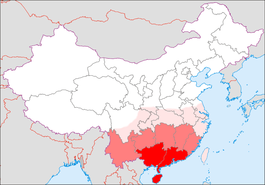South China (pinyin: Huá'nán) is a geographical and cultural region that covers the southernmost part of China. Its precise meaning varies with context. A notable feature of South China in comparison to the rest of China is that most of its citizens are not native speakers of Standard Chinese. Cantonese is the most common language in the region while the Guangxi region contains the largest concentration of China's ethnic minorities.

Medium Red: South China according to the 1945–1949 definition
Light Red: Southern China (a much broader area)
Administrative divisions
edit| GB[1] | ISO №[2] | Province | Chinese Name | Capital | Population | Density | Area | Abbreviation/Symbol | |
|---|---|---|---|---|---|---|---|---|---|
| Yuè | 44 | Guangdong Province | 广东 Guǎngdōng Shěng Gwong2dung1 Saang2 |
Guangzhou | 104,303,132 | 579.46 | 180,000 | GD | 粤 |
| Guì | 45 | Guangxi Zhuang Autonomous Region | 广西 Guǎngxī Zhuàngzú Zìzhìqū Gwong2sai1 Zong3zuk6 Zi6zi6keoi1 |
Nanning | 46,026,629 | 195.02 | 236,000 | GX | |
| Qióng | 46 | Hainan Province | Hǎinán Shěng Háinâm Téng |
Haikou | 8,671,518 | 255.04 | 34,000 | HI | 琼 |
| Gǎng | 91 | Hong Kong Special Administrative Region | Xiānggǎng Tèbié Xíngzhèngqū Hoeng2gong1 Dak6bit6 Hang4zing3keoi1 |
Tamar | 7,061,200 | 6,396.01 | 1,104 | HK | |
| Ào | 92 | Macau Special Administrative Region | 澳门 Àomén Tèbié Xíngzhèngqū Ou3mun2 Dak6bit6 Han4zing3keoi1 |
Macau | 552,300 | 19,044.82 | 29 | MC | 澳 |
Cities with urban area over one million in population
editProvincial capitals in bold.[original research?]
| # | City | Urban area[3] | District area[3] | City proper[3] | Prov. | Census date |
|---|---|---|---|---|---|---|
| 1 | Shenzhen | 10,358,381 | 10,358,381 | 10,358,381 | GD | 2010-11-01 |
| 2 | Guangzhou | 9,702,144 | 11,071,424 | 12,701,948 | GD | 2010-11-01 |
| 3 | Dongguan | 7,271,322 | 8,220,207 | 8,220,207 | GD | 2010-11-01 |
| 4 | Hong Kong | 7,071,576 | 7,071,576 | 7,071,576 | HK | 2011-06-30[4] |
| 5 | Foshan | 6,771,895 | 7,197,394 | 7,197,394 | GD | 2010-11-01 |
| 6 | Shantou | 3,644,017 | 5,329,024 | 5,389,328 | GD | 2010-11-01 |
| 7 | Zhongshan | 2,740,994 | 3,121,275 | 3,121,275 | GD | 2010-11-01 |
| 8 | Nanning | 2,660,833 | 3,434,303 | 6,658,742 | GX | 2010-11-01 |
| 9 | Huizhou | 1,807,858 | 2,344,634 | 4,598,402 | GD | 2010-11-01 |
| 10 | Haikou | 1,517,410 | 2,046,170 | 2,046,170 | HI | 2010-11-01 |
| 11 | Jiangmen | 1,480,023 | 1,822,614 | 4,450,703 | GD | 2010-11-01 |
| 12 | Liuzhou | 1,410,712 | 1,436,599 | 3,758,704 | GX | 2010-11-01 |
| 13 | Zhuhai | 1,369,538 | 1,562,530 | 1,562,530 | GD | 2010-11-01 |
| 14 | Zhanjiang | 1,038,762 | 1,611,868 | 6,994,832 | GD | 2010-11-01 |
| 15 | Macau | 552,503 | 552,503 | 552,503 | MO | 2011-08-12[5] |
Namesake
editSee also
edit- Lingnan
- List of regions of China
- Southern China
- South Central China — includes South China and "Central China" provincial-level subdivisions.
- Southern China
References
edit- ^ GB/T 2260 codes for the provinces of China
- ^ ISO 3166-2:CN (ISO 3166-2 codes for the provinces of China)
- ^ a b c
国 务院人口 普 查办公 室 ;国家 统计局 人口 和 社会 科技 统计司 , eds. (2012).中国 2010年 人口 普 查分县资料 . Beijing:中国 统计出版 社 [China Statistics Press]. ISBN 978-7-5037-6659-6. - ^ Census and Statistics Department, ed. (2012).
香港 2011年 人口 普 查 –主要 報告 . Hong Kong: Government Logistics Department. - ^ Direcção dos Serviços de Estatística e Censos, Macau (2012). 15th Macau Census (2011). Macau: Direcção dos Serviços de Estatística e Censos.